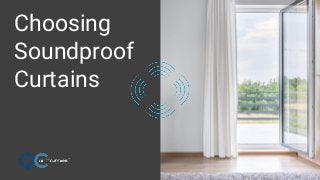
Choosing soundproof curtains
- 2. STEP 1: IDENTIFY YOUR NOISE PROBLEM Most people have either a problem with sound blocking or sound absorbing.
- 3. Sound Blocking These are used to prevent sound from traveling from one area to another by reflecting sound. ● Noisy neighbors ● High traffic ● Kids playing ● Loud music ● City noise
- 4. Sound Absorbing Sound Absorbing material takes in energy from sound waves and dissipates it through the material and as heat. ● Echo and reverb ● Noisy open office ● Music studio ● Good acoustics ● Home theater
- 5. Sound Absorbing Sound Absorbing material takes in energy from sound waves and dissipates it through the material and as heat. ● Porous ● Less Dense ● Lots of folds Sound Blocking Sound blocking materials typically are dense and heavy to prevent sound from leaking through. ● Dense Material ● Heavy Material
- 6. STEP 2: LOOK FOR LAB RATINGS To ensure the reliability of a sound control product many companies will have their product tested in a lab. Sound Blocker - STC Rating Sound Absorber - NRC Value
- 7. Sound Absorbing Rates the amount of sound being absorbed by a particular surface from 0 to 1. A value of 1 means that 100% of the sound is being absorbed.t NRC Value Sound Blocking STC Rating The STC rating roughly correlates to the number of dB that a material could be considered to block. A 10 dB noise reduction is perceived as a halving of the noise. Look for curtains with a rating of STC 15, STC 20, or higher. Look for curtains with a rating of close to 1.
- 8. STEP 3: LOOK FOR CURTAINS Armed with these tools you will have a better idea of what to look for and what actually works. A lot of products use these terms loosely as marketing jargon, and have little real benefit in these departments. If you want something that works look for these terms.
- 9. Shop for Curtains For more information or to shop curtains visit: www.acoustic-curtains.com